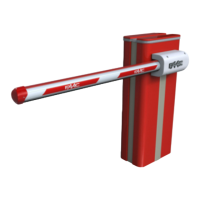B680H 15 732719 - Rev.D
Translation of the original instructions
ENGLISH
Display
Function
Default
P4
Output 4 Polarity
Output 4 polarity, see parameter regarding “Output
1 Polarity”
no
o5
Output 5
Output 5 signal type, see “Output 1”
02
P5
Output 5 polarity
Output 5 polarity, see parameter for “Output 1
polarity”
no
o6
Output 6
Output 6 signal type, see “Output 1”
04
P6
Output 6 polarity
Output 6 polarity, see parameter for “Output 1
polarity”
no
o7
Integrated flashing lamp operating mode
Lets you choose between two operating modes for
the integrated flashing lamp (if present) connected
to output J18.
01 “Traffi c light” mode (steady green when
paused/open, fl ashing red when moving,
steady red when closed)
02 ”Flashing lamp” mode (fl ashing red when
bar is moving, off in all other cases)
01
AS
Service request (linked to the following two
functions):
If activated, at the end of the countdown (which can
be set with the two following “Cycle Programming”
functions) it activates the LAMP output for 4 sec
every 30 sec (service request). It can be useful for
setting programmed maintenance work.
Y Active
no Disabled
no
nc
Cycle programming in thousands:
Is used to set a countdown of the system operation
cycles; the value can be set from 0 to 99 (thousands
of cycles). The value displayed is updated with the
succession of the cycles, interacting with the value
of
nC (99 decrements of nc correspond to 1
decrement of
nC).
The function can be used, together with
nC, to
verify the use of the system and for use of “Service
Request”.
00
nC
Cycle programming in hundreds of thousands:
Is used to set a countdown of the system operation
cycles; the value can be set from 0 to 99 (hundreds
of thousands of cycles). The value displayed
is updated with the succession of the cycles,
interacting with the value of
nc. (1 decrement of
nC corresponds to 99 decrements of nc).
The function can be used, together with
nc, to
verify the use of the system and for use of “Service
Request”.
01
St
AUTOMATED SYSTEM STATUS:
This allows you to choose whether to quit the programme
and save the data.
Y = quit and save the data
no = quit without saving the data
On quitting the programme, press the F key to display again
the status of the automated system.
You can go to St at any time by simultaneously pres-
sing F and -
6.1 Confi guring the loop detector
The E680 board features an integrated metal mass detector for the
induction detection of vehicles.
6.1.1 Specifi cations:
• Galvanic separation between the detector electronics and the
loop electronics
• Automatic alignment of the system immediately following activation
• Continuous resetting of the frequency drifts
• Sensitivity independent of loop inductivity
• Adjustment of the loop work frequency with automatic selection
• Occupied loop message with LED display
• Loop status addressable on outputs
6.1.2 Connection:
Connect the loops according to the layout on page 7, Fig. 2
- Terminals 24 - 25 for LOOP 1 = loop with gate opening function;
- Terminals 26 - 27 for LOOP 2 = loop with closing and/or safety when
closing function.
For more information on the effect of the loop signals on the automated
system, refer to the logics tables in paragraph 10 “OPERATING
LOGICS TABLE”.
To enable the functionality of the connected loops, enter BASIC
programming mode and set parameters
L1 and L2 on Y consistently with
the number and type of connected loops. If only one loop is installed,
enable only the corresponding programming step.
The loop detector operating status is indicated by the DL3 and DL4
status LEDs.

